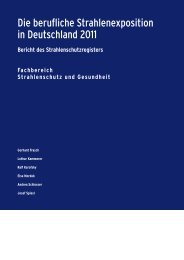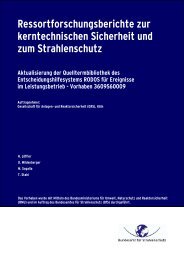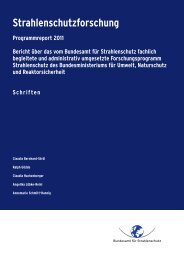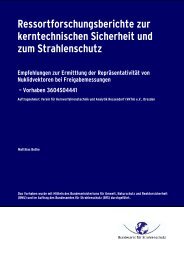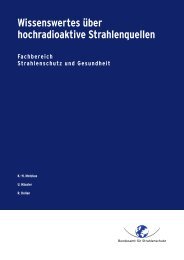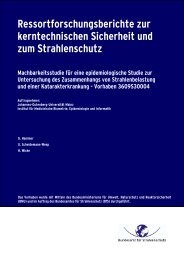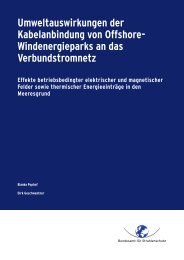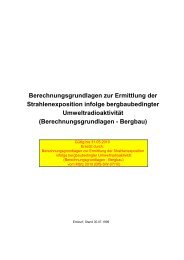Programmreport 2012 - DORIS - Bundesamt für Strahlenschutz
Programmreport 2012 - DORIS - Bundesamt für Strahlenschutz
Programmreport 2012 - DORIS - Bundesamt für Strahlenschutz
Erfolgreiche ePaper selbst erstellen
Machen Sie aus Ihren PDF Publikationen ein blätterbares Flipbook mit unserer einzigartigen Google optimierten e-Paper Software.
of H-1-CSI of approximately 12 mm, functional imaging is suitable for biologically adapted radiotherapy only<br />
to a limited extent. For this purpose, PET/CT is considerably better suited due to the much better spatial resolution<br />
of up to 4.6 mm. This technology additionally allows for dynamic FDG-PET and DCE-CT measurements<br />
for quantitative characterisation of energy metabolism and microcirculation in a single session. The application<br />
and testing of the developed medical physics methods in a radiotherapy study of patients with brain<br />
metastases was started. In the second part of the project, the effect of the static magnetic field on microcirculation<br />
in the muscle of subjects at three MR systems with magnetic flux densities of 1.5, 3 and 7 T should be<br />
investigated. To this end, appropriate measurement techniques have been implemented and validated at the<br />
three systems. Unfortunately, the study with healthy volunteers could not be carried out as planned, as a<br />
whole-body coil was unexpectedly not available.<br />
Within the frame of the project “Construction of hybrid voxel models for optimising image quality<br />
and dose in radiography (3609S40002)“ the following results could be achieved: High-resolution scans<br />
of anatomic specimens, a program tool for incorporating the high-resolution partial body voxel phantoms into<br />
existing reference voxel models, a Monte Carlo radiation transport code that can perform simulations in phantoms<br />
combining various resolutions, and first imaging simulations using such phantoms. The project progress<br />
was hampered by various serious problems, so that the final simulation calculations for the assessment of image<br />
quality could not be performed during the project term. Nevertheless, all methods originally planned to be<br />
used were developed successfully, and possible solutions for the open problems were worked out.<br />
In the project “Feasibility study for the assessment of medical ionising radiation exposure in the<br />
Helmholtz Cohort (German National Cohort) (3610S40001)“ the feasibility of assessing medical radiation<br />
exposures was investigated. Initially a questionnaire for use in the feasibility study was constructed using<br />
available literature. Details of previous x-ray examinations were collected from 199 participants (87 male, 112<br />
female) of the Bremen and Hamburg study centers during face-to-face interviews. All participants reported<br />
having been x-rayed and the most common examinations were dental, upper and lower extremities and chest<br />
x-rays. The most common examination among the 90 (45%) participants who reported CT examinations was<br />
of the skull. Manufacturer's recommendations, guidelines of the German Medical Association as well as conversion<br />
factors published by Drexler et al. 1993 were used to retrospectively estimate organ doses. For CT<br />
examinations, the software CT-Expo was used. A total mean dose of 0.6 mSv was calculated for chest examinations,<br />
with 0.11 mSv for the adrenal glands and the lungs. A mean total organ dose of 52.9 mSv was estimated<br />
for skull-CT examinations.<br />
Within the cohort study on the prevalence of congenital anomalies in the vicinity of nuclear power plants a<br />
higher risk of congenital anomalies was observed amongst children of mothers who were potentially exposed<br />
to ionising radiation in the first trimester of their pregnancy. Since this observation was based only on a small<br />
number of cases the question needed further clarification. Within this feasibility study “Risk for congenital<br />
anomalies in the offspring of women occupationally exposed to ionising radiation in the<br />
medical-diagnostic field (3610S40004)“ contact logistics and recruitment were tested as well as the logistics<br />
for examination of newborn children on congenital anomalies. Since the recruitment via the Radiation<br />
Protection Register of the Federal Office for Radiation Protection (BfS) led to an unexpected low participation<br />
rate an extensive non-responder-analysis was conducted and an alternative recruitment method was tested.<br />
Moreover, dose values for the participating mothers were extracted from the Radiation Protection Register.<br />
For the purpose of data quality validation, a population based comparison cohort from the birth register<br />
"Mainzer Modell" was utilized. Data on radiation exposure of the parents of the newborns were collected within<br />
this comparison group. Based on the results of this feasibility study, the study protocol design for a larger cohort<br />
study was developed.<br />
SUBJECT AREA 05 - RADIOECOLOGY<br />
The estimation of radiation exposures may exhibit uncertainties concerning the scenario, the model structure<br />
and the parameters of exposure models. The project “Comparative examination of probabilistic/stochastic<br />
and deterministic exposure modelling with regard to the reliability of the modelling results<br />
and the requirements concerning the quality of input data (3609S50002)“ focused on the investigation<br />
and comparative assessment of techniques for the consideration of parameter uncertainties by<br />
means of conservative deterministic approaches and probabilistic model calculations using Monte Carlo simulations<br />
and Bayesian methods, respectively. In addition, alternative methods for uncertainty modelling like<br />
evidence and possibility theory, and the conceptual disparities between probabilistic and stochastic modelling<br />
XXII



